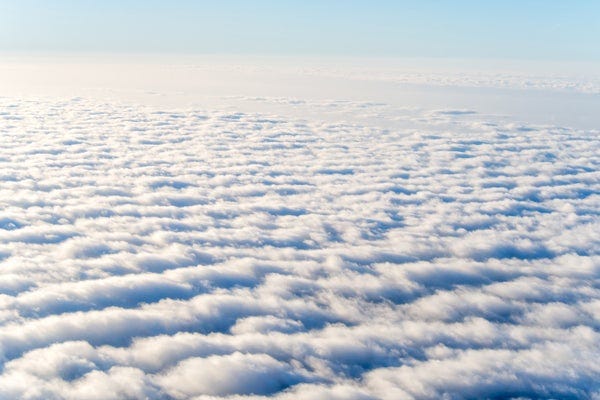Notes from the edge of civilization: Apr. 7, 2024 (Eclipse edition)
Tomorrow the moon gets its revenge. Scientists reluctantly salt the sky. The mid-east is under pressure. And, bridges beware.
This is our last message to you from the ‘before’ times — before the eclipse, that is. Starting in about 24 hours, the moon will blot out the sun for about 4 minutes over a large portion of North America. Millions of people will travel thousands of miles (think of the carbon footprint!) just for the chance to watch this frankly not-that-uncommon natural phenomenon through a thin sheet of colored plastic film. Many more will gnaw their fingernails in anxious anticipation of some potentially destructive seismic events to follow.
Between two and five solar eclipses happen somewhere in the world each year. The average middle-aged American has already lived through two total solar eclipses over the United States (1979 and 2017) and the third will take place tomorrow. So, it’s not THAT rare… Why, then, are we losing our minds, calling in the National Guard, and stocking up on essentials?
“Here is my only prediction about the April 8th eclipse,” cycles analyst Cyrus D. Harding recently told us. “It will be closely followed by April 9th.”
Wise words, Cyrus. Wise words indeed.
When the sun gets eaten by the moon
From Sun Chips to MoonPies, the Great American Eclipse™ is more evidence we're living through a most idiotic time in human history.
All the while we’re being so easily distracted by a momentary solar shrouding, tensions in the Middle East are ratcheting up. Hostilities are on the rise between Iran and Israel, with a regional war now possible after an Israeli air strike last week on the Iranian embassy in Damascus killed seven people. As of this morning, Yemen has offered Iran over 400,000 fighters for a potential regional conflict, according to unverified reports on X.
This comes as dozens of U.S. Democrats sent a letter to the President and Secretary of State on Friday urging them to halt defense aid to Israel.
"In light of the recent strike against aid workers and the ever-worsening humanitarian crisis, we believe it is unjustifiable to approve these weapons transfers," the lawmakers stated in the letter addressed to President Biden and Secretary of State Antony Blinken.
Meanwhile, at a cabinet meeting on Sunday marking six months since the Gaza war broke out, Benjamin Netanyahu said Israel was "one step away from victory." He vowed there would be no truce until all remaining hostages are freed.
We’ll see how this plays out in the coming weeks.
Although Monday’s eclipse is transient, efforts are underway to obstruct the sun more permanently as a way to tackle climate change.
The nation's first outdoor test to limit global warming by increasing cloud cover launched Tuesday from the deck of a decommissioned aircraft carrier in the San Francisco Bay.
The experiment, which organizers didn't widely announce to avoid public backlash, marks the acceleration of a contentious field of research known as solar radiation modification. The concept involves shooting substances such as aerosols into the sky to reflect sunlight away from the Earth.
So contentious is this field of research — which is now being dubbed “marine cloud brightening” presumably because previous attempts at “solar dimming” didn’t play well with the public — that even environmentalists are worried. “You could well be changing climatic patterns, not just over the sea, but over land as well,” David Santillo, a senior scientist at Greenpeace International, told The New York Times. “This is a scary vision of the future that we should try and avoid at all costs.”
No duh.
Cloud researchers (yes, that’s a thing) interviewed by the Times agree that the risks haven’t been fully assessed.
“I hope, and I think all my colleagues hope, that we never use these things, that we never have to,” said Sarah Doherty, an atmospheric scientist at the University of Washington and the manager of its marine cloud brightening program.
She said there were potential side effects that still needed to be studied, including changing ocean circulation patterns and temperatures, which might hurt fisheries. Cloud brightening could also alter precipitation patterns, reducing rainfall in one place while increasing it elsewhere.
Feels like yet another example of a technology no one wants that’s coming anyway.
Two weeks after a container ship lost power and ran into the Francis Scott Key Bridge in Baltimore, bringing the bridge down and paralyzing the city’s port, another similar incident just took place.
A massive container ship reportedly lost power on the Upper New York Bay — just before the Verrazzano-Narrows Bridge connecting the New York City boroughs of Staten Island and Brooklyn.
According to Captain John Konrad, CEO of gCaptain, a New York City tugboat captain informed him that the 354-meter container ship APL QINGDAO "lost power while transiting New York harbor."
"They had 3 escort tugs but 3 more were needed to bring her under control. They regained power & were brought to anchor near the Verrazano bridge," the tugboat captain told Konrad.
Avast ye maties! One more of these and we might have a pattern starting to emerge. But then, we’d probably be considered conspiracy wingnuts anyway. Yaaaaar.






